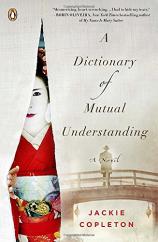A Dictionary of Mutual Understanding
Review
A Dictionary of Mutual Understanding
A horribly disfigured Japanese man knocks on the door of Amaterasu Takahashi one cold Pennsylvania morning and introduces himself as her grandson, Hideo. She knows this cannot be true. On August 9, 1945, the pikadon had obliterated Nagasaki, which included Hideo’s school and the church where his mother, Yuko, was praying. She believes that neither Hideo nor Yuko survived the blast because she and her husband searched hospitals, stores and schools for weeks afterward. However, the man hands her a letter from his adopted mother setting an impossible task: Amaterasu must imprint the sweet seven-year-old Hideo she had waved goodbye to over 40 years ago onto this gentle but cruelly scarred man.
In her debut novel, A DICTIONARY OF MUTUAL UNDERSTANDING, Jackie Copleton explores the anguish of three generations who are torn apart at the end of World War II.
"The regrets and mistakes of Amaterasu’s life are revealed through conversations, letters and well-done flashbacks, real and convincing."
Amaterasu needs to open her own life for inspection before she can even consider Hideo to be the last remaining member of her family. Hideo is staying nearby for a few days at a conference, and he promises to return for more conversation. He gives her a package of letters from the man who loved Yuko, all dated August 9th in one-year intervals commemorating her death. Amaterasu reads each one, deeply moved by the revelations. Now, decades after the pikadon, she relives her life and the choices she has made.
When the deformed man returns the next day, he apologizes for the shock he must have given her and explains that he has suffered a form of amnesia that has blocked out what happened on the day of the blast as well as the years before. He had been taken to an orphanage where he healed and had surgery for his burns, but knows nothing of his past. He believes Amaterasu to be his grandmother because his adopted mother and father had tried their best to identify him by age and by first name/location. Amaterasu will show us there are many more layers of family and relationships than we first see.
He looks at the pictures of Japan on the living room wall, the only homage to her home country among the American furnishings. She wants him to leave, but “curiosity and loneliness are terrible accomplices,” so she invites him to stay for a drink. She explains the film Invasion of the Body Snatchers and how she and her husband were to be the aliens when they first came to the United States, trying to assimilate into a new world. Even though they had no connection to the US, and learning the language and customs of a new country would be very hard, they could not bear to live in Nagasaki.
The few days of Hideo’s conference go by, and Amaterasu contemplates the choices she has before her. To accept this man as her grandson means she must remember him and their life together. She quizzes him about the last thing he saw in their garden as they walked to school that morning: he remembers a bright green snake, coiled on a rock. Who wouldn’t remember that?
Copleton opens each short chapter with a definition of a Japanese word, among them Geisha, Ue-shita (relationships between superordinate and subordinate) and Itako (divinely inspired women). Each definition is brought into rich focus by the events of the chapter and adds to the heritage of the Japanese throughout WWII and thereafter.
The regrets and mistakes of Amaterasu’s life are revealed through conversations, letters and well-done flashbacks, real and convincing. We learn in the end that self-acceptance is a difficult, harsh task. Copleton allows us to believe it can be done.
Reviewed by Jane Krebs on December 3, 2015
A Dictionary of Mutual Understanding
- Publication Date: December 1, 2015
- Genres: Fiction
- Paperback: 304 pages
- Publisher: Penguin Books
- ISBN-10: 0143128256
- ISBN-13: 9780143128250





